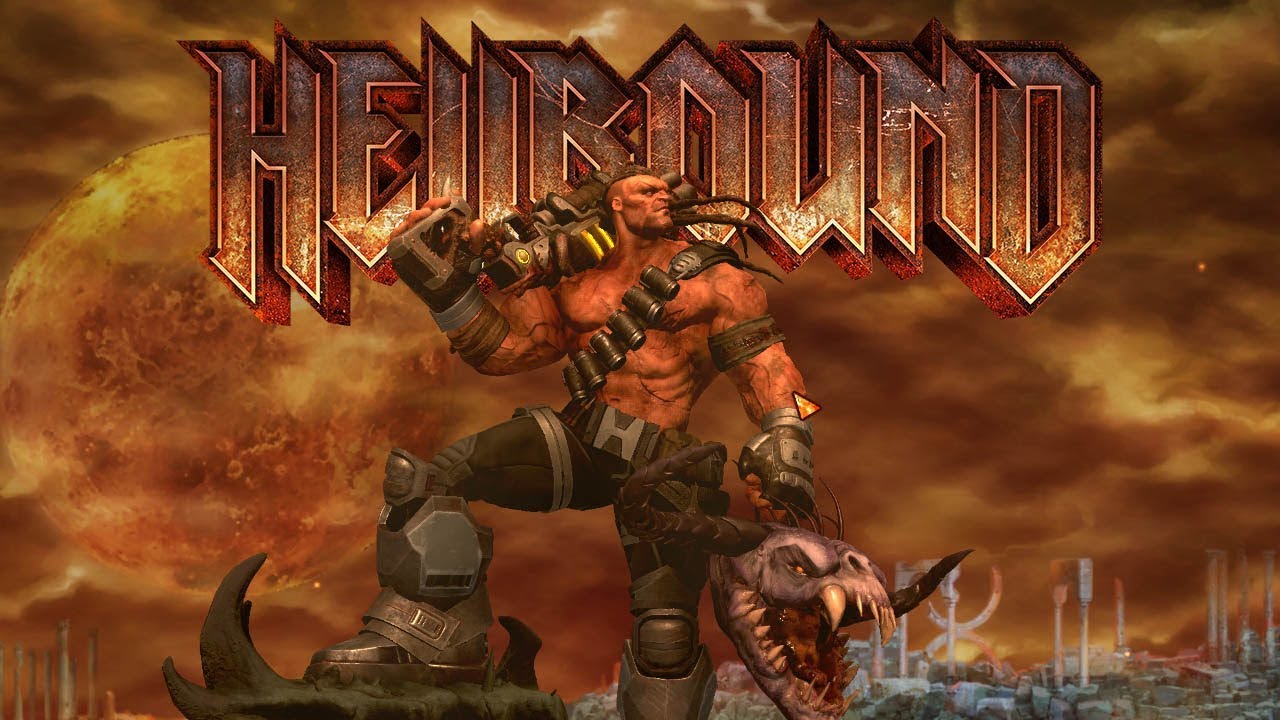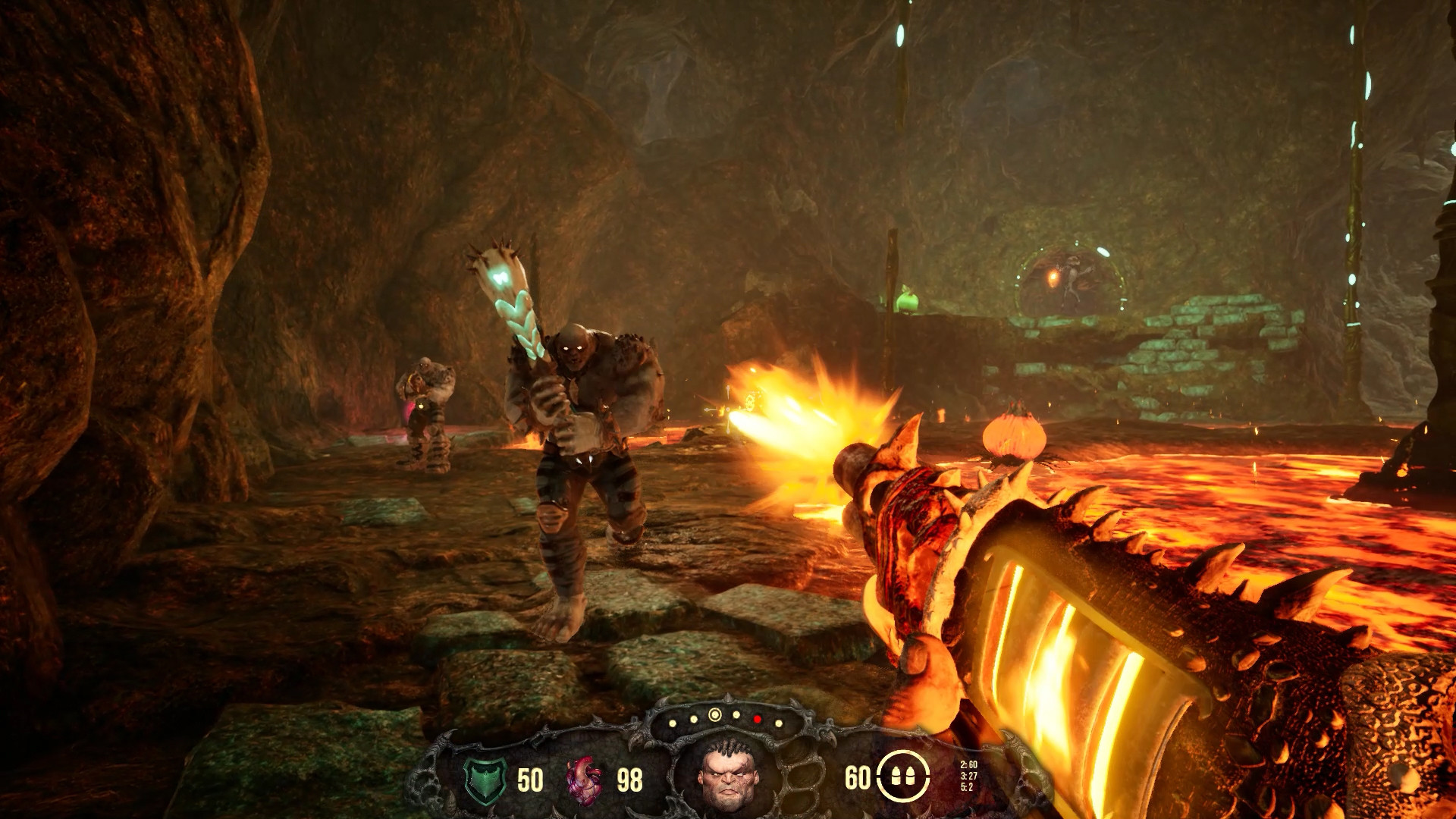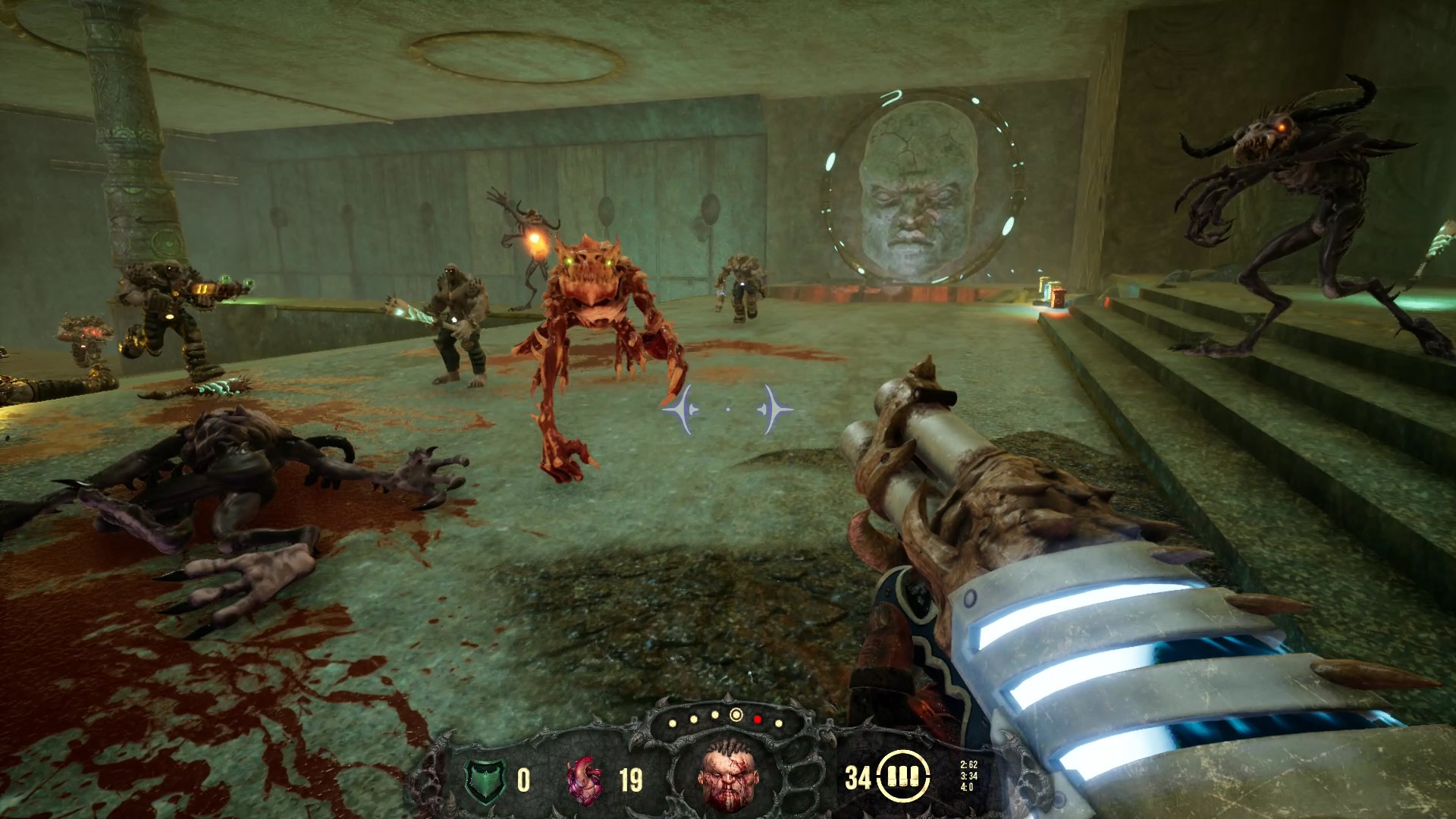The header image for Hellbound on its Steam store page describes it as a “90s FPS, 30 years later,” and I couldn’t possibly think of a more apt summary.
For better or worse, playing Hellbound feels like you found an old Game Design Document for a hellish, bloody shooter conceived at the height of 90s shooter fever and gave it to a 2020 development studio.
Hell is invading with demons. You’re a big, strong, one-liner tough guy with massive guns, a cool temper, and a gravelly voice. There’s some cursing, some blood, and lots of bullets to go around. That’s it, that’s the formula, and it mostly nails what it’s going for.
You can finish the entirety of Hellbound in just around three hours on normal difficulty, including all the times you’ll die. It’s pretty short — even by retro standards. I livestreamed the entire thing in one go — you can watch it here or above if you’d like.
One of the major draws for Hellbound then, just like the old-school shooters that inspired it, is the satisfaction of finishing levels on hard difficulties and sprinting through them quickly. At the end of each, you’ll be graded on how many enemies you kill, how many items you find, and how many secrets you uncover, in addition to your completion time.
Not only that, but the game literally warns you in the intro splash screen that it’s designed to be difficult, just like the 90s, and states that not everyone will like it for that reason.
You’d have to be a bit of a sadist to dive into the high difficulties head first here, but I fully expect some people to enjoy that particular type of self-punishment. I’d say Hellbound is certainly hard but not as brutal as the blood-soaked games of yore. A generous system that allows you to save at literally any moment goes a long way towards making it more palatable, as do the stylish and polished visuals.
That being said, the publisher is well aware of the type of game this is, certainly factoring in the short length, and has priced Hellbound accordingly (it’s only $15 at full-price and has a launch discount right now), so don’t expect to get a dozen or more hours out of this campaign unless you replay it several times on higher difficulties.
Weapon variety is a bit of a sore spot. Even if I only end up using the shotgun for 90% of the game, as was the case here, I still like knowing I have a bunch of other cool weapons to pick in a pinch. In Hellbound, you’ve got your bare hands, a big two-handed melee club, a basic semi-auto rifle, a triple shotgun, a minigun, and a rocket launcher. That’s it.
Each weapon in Hellbound has an alternate function, like the semi-auto rifle and minigun let you aim down sights with a right-click, whereas the triple shotgun shoots out three shots instead of one, and the rocket launcher becomes a grenade launcher. That helps with the variety, but it still seems a little paltry. Given the short length and small level count, it wasn’t surprising, though.
More impactful to the generally repetitive feeling is the fact that there are just four enemies in the entire game, other than the boss. You’ve got the basic grunts, who all mix up and use any one of your various weapons, a larger version of those guys that always has rockets, a tall enemy that throws fireballs just like the Imp from Doom, and four-legged crawlers that charge and leap at you to deal massive amounts of damage. They’re also faster than you even if you sprint, which can cause some real chaos.
Map variety on the other hand is quite nice. Levels are just large enough to encourage exploration but never devolve into aimless labyrinths, ensuring you’ve always got a way forward laid before you.
It all looks like you’re in Hell no matter what, which is appropriate, but there is still a good deal of visual variety. I particularly liked the outdoor environments with enormous, red glowing moons in the distant sky and swirling vortexes of energy that all felt truly captivating.
The world-building is pretty generic, though, as literally every line of dialogue and loading screen description, as well as the overall aesthetic, could’ve been ripped directly from a Doom game and you’d have never known the difference. It almost feels like Hellbound is just a really sophisticated Doom spin-off mod.
Speaking of, Hellbound feels made for mod support. Give intrepid players the ability to add in new weapons, new enemies, new levels, or at least new survival maps, and this game could go on to have a truly dedicated fanbase. There is a ton of potential.
After you finish the main campaign’s seven maps (that’s six larger levels and a final boss fight), there’s a wave-based survival mode that’s heavily focused on how long you can stay alive while reaching a high score. It’s addictive and the overall frenetic gameplay is honestly a bit more suited to this game mode than the campaign itself given how satisfying it is to strafe and sprint backwards while shooting. You’ll need to have top-notch kiting skills to last longer than just a few minutes on any of the survival maps.
Hellbound is a well-paced shooter that doesn’t hang you up with obtuse puzzles or awkward platforming very often. The jump button is really only used as a means-to-an-end, and you shouldn’t need to worry about too many death pits here. Movement is extremely fast, slick, and smooth, so it always feels really great to tear through the game’s environments.
There is one section near the end of a late level that involves scouring a multi-tiered structure to locate switches where an elevator bugged out on me once, and I also had one crash to desktop, but other than that, it was pretty flawless from a performance perspective on high settings.
Hellbound Review — The Bottom Line
Pros
- Fast, snappy controls
- Aesthetic, structure, and premise feel ripped directly from a 90s-era Game Design Document
- Extremely bloody gameplay
- Very satisfying shotgun
- Absolutely rocking soundtrack
Cons
- Very short campaign (just around three hours)
- Lack of enemy variety
- A small handful of weapons
- Just one boss fight at the very end
Hellbound is the kind of game that you’ll know you’ll want to play or not just by reading the summary or glancing at screenshots. If you’re a fan of 90s-era retro FPS games like Doom and Quake, then there is an extremely high chance you’ll appreciate this particular brand of punishing, yet rewarding, demon slaughter.
There are plenty of ways Hellbound could have expanded beyond the framework it borrows from to color outside the lines a bit, but even as a play-it-safe tribute to 90s shooter royalty, it still manages to serve up a cold, hard dish of bloody brutality gritty enough to make Doom Guy blush.
[Note: A copy of Hellbound was provided by Nimble Giant Entertainment for the purpose of this review.]












Published: Aug 7, 2020 12:36 PM UTC